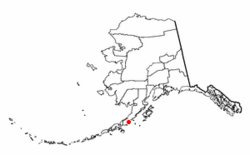Chignik Lagoon, Alaska facts for kids
Quick facts for kids
Chignik Lagoon, Alaska
Nanwarnaq
|
|
|---|---|

Location of Chignik Lagoon, Alaska
|
|
| Country | United States |
| State | Alaska |
| Borough | Lake and Peninsula |
| Area | |
| • Total | 13.25 sq mi (34.32 km2) |
| • Land | 13.25 sq mi (34.32 km2) |
| • Water | 0.00 sq mi (0.00 km2) |
| Population
(2020)
|
|
| • Total | 72 |
| • Density | 5.43/sq mi (2.10/km2) |
| Time zone | UTC-9 (Alaska (AKST)) |
| • Summer (DST) | UTC-8 (AKDT) |
| ZIP code |
99565
|
| Area code(s) | 907 |
| FIPS code | 02-13670 |
Chignik Lagoon is a small community in Alaska, United States. Its name in the Alutiiq language is Nanwarnaq. It is called a census-designated place (CDP). This means it is an area that the government counts for population, but it is not an official city or town. In 2020, about 72 people lived there. Chignik Lagoon is located in the Lake and Peninsula Borough.
Contents
Exploring Chignik Lagoon's Location
Chignik Lagoon is found in a special part of Alaska. It sits on the southeast side of a water area also called Chignik Lagoon. This water area is a tidal inlet, meaning the water level changes with the ocean tides.
Where is Chignik Lagoon?
The community is located at 56.307535 degrees north and 158.535023 degrees west. To its east, you will find the city of Chignik.
Land Area of the Community
The total land area of Chignik Lagoon is about 34.32 square kilometers (13.25 square miles). All of this area is land, with no water within its boundaries.
Connecting Communities by Road
In 2009, a special project began to build roads in the area. The Marines helped with this. They started building a road to connect Chignik Lagoon with Chignik Lake. This was the first step in a bigger plan. The goal is to eventually link Chignik Lagoon, Chignik Lake, and Chignik by road. This will make it easier for people to travel between these communities.
Understanding Chignik Lagoon's Population
The number of people living in Chignik Lagoon has changed over the years. The United States Census Bureau counts the population every ten years. This helps us understand how communities grow or shrink.
| Historical population | |||
|---|---|---|---|
| Census | Pop. | %± | |
| 1960 | 108 | — | |
| 1980 | 48 | — | |
| 1990 | 53 | 10.4% | |
| 2000 | 103 | 94.3% | |
| 2010 | 78 | −24.3% | |
| 2020 | 72 | −7.7% | |
| U.S. Decennial Census | |||
History of Population Counts
Chignik Lagoon first appeared in the U.S. Census in 1960. Before that, it might have been part of a larger settlement called Chignik Bay. In the past, there were fish canneries here. After 1960, it was not counted in 1970. But since 1980, it has been counted as a census-designated place in every census.
Who Lives in Chignik Lagoon?
In 2000, there were 103 people living in Chignik Lagoon. These people lived in 33 households, and 22 of these were families. Most of the people living there were Native American. Some residents were White, and a small number were Black or African American, or from two or more races.
Many households had children under 18 living with them. Most households were married couples living together. The average household had about three people.
Age and Income in the Community
The people in Chignik Lagoon are of different ages. In 2000, about 31% of the population was under 18 years old. About 16% were young adults aged 18 to 24. The median age was 26 years old, meaning half the people were younger and half were older than 26.
The average income for a household in 2000 was about $92,297. For families, the average income was about $99,054. These numbers show that the community had a good income level at that time.
See also
 In Spanish: Chignik Lagoon (Alaska) para niños
In Spanish: Chignik Lagoon (Alaska) para niños

